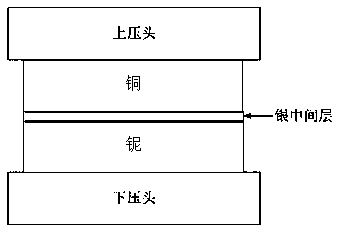Copper and niobium connector and connecting method thereof
A connection method and a technology of connectors, which are applied in welding equipment, non-electric welding equipment, metal processing equipment, etc., can solve problems such as difficulties, limited mutual solubility, difficult connection strength between copper and niobium, and copper-niobium cavity performance, etc., to achieve Good strength and deformability, the effect of simple method
- Summary
- Abstract
- Description
- Claims
- Application Information
AI Technical Summary
Problems solved by technology
Method used
Image
Examples
Embodiment 1
[0023] A copper plate with a thickness of 8 mm and a niobium plate with a thickness of 1 mm are used as connecting materials, and a silver foil with a thickness of 100 μm is used as an intermediate layer. Use 1000#, 1200#, 1500# SiC sandpaper to polish the surface to be connected of the copper plate and the niobium plate in turn until the surface roughness is 3 μm. Put it in acetone for ultrasonic cleaning for 10min, take it out and air dry. Assemble together from top to bottom in the order of copper plate / silver foil / niobium plate. Put the workpieces to be connected into the heating furnace, and apply 10MPa axial pressure to the workpieces through the upper and lower pressure heads. Close the oven door and evacuate to 5 × 10 -3 Pa. Then heated to 750 ºC at a rate of 20 ºC / min, kept for 30 min, then heated to 850 ºC at a rate of 10 ºC / min, kept for 60 min, and finally cooled to room temperature at a rate of 5 ºC / min to obtain niobium-silver-copper Connectors, when the ben...
Embodiment 2
[0025] A copper plate with a thickness of 8 mm and a niobium plate with a thickness of 2 mm were used as connecting materials, and the surfaces to be connected of the copper plate and the niobium plate were polished with 1000#, 1200#, and 1500# SiC sandpaper in sequence until the surface roughness was 3 μm. Put it in acetone for ultrasonic cleaning for 10min, take it out and air dry. Silver particles with a thickness of 80 µm and an average particle diameter of 20 µm were spread between the copper plate and the niobium plate. Put the workpieces to be connected into the heating furnace, and apply 25MPa axial pressure to the workpieces through the upper and lower pressure heads. Close the oven door and evacuate to 5 × 10 -3 Pa. Then heated at a rate of 20 ºC / min to 750 ºC, kept for 40 min, then heated to 850 ºC at a rate of 10 ºC / min, kept for 60 min, and finally cooled to room temperature at a rate of 10 ºC / min to obtain niobium-silver-copper Connectors, when the bending ang...
Embodiment 3
[0027] A copper plate with a thickness of 8 mm and a niobium plate with a thickness of 1 mm were used as connection materials, and the surfaces to be connected of the copper plate and the niobium plate were polished with 1000#, 1200#, and 1500# SiC sandpaper in sequence until the surface roughness was 2 μm. Put it in acetone for ultrasonic cleaning for 10min, take it out and air dry. Using magnetron sputtering technology, 20 μm and 20 μm silver layers were deposited on the surfaces of the copper and niobium plates to be connected, respectively. Assemble together from top to bottom according to the sequence of copper plate (silver plated surface) / (silver plated surface) niobium plate. Put the workpieces to be connected into the heating furnace, and apply 20MPa axial pressure to the workpieces through the upper and lower pressure heads. Close the furnace door and evacuate to 3 × 10-3 Pa. Then heated to 750 ºC at a rate of 15 ºC / min, kept for 50 min, then heated to 850 ºC at a ...
PUM
| Property | Measurement | Unit |
|---|---|---|
| thickness | aaaaa | aaaaa |
| surface roughness | aaaaa | aaaaa |
| thermal conductivity | aaaaa | aaaaa |
Abstract
Description
Claims
Application Information
 Login to View More
Login to View More - R&D
- Intellectual Property
- Life Sciences
- Materials
- Tech Scout
- Unparalleled Data Quality
- Higher Quality Content
- 60% Fewer Hallucinations
Browse by: Latest US Patents, China's latest patents, Technical Efficacy Thesaurus, Application Domain, Technology Topic, Popular Technical Reports.
© 2025 PatSnap. All rights reserved.Legal|Privacy policy|Modern Slavery Act Transparency Statement|Sitemap|About US| Contact US: help@patsnap.com

